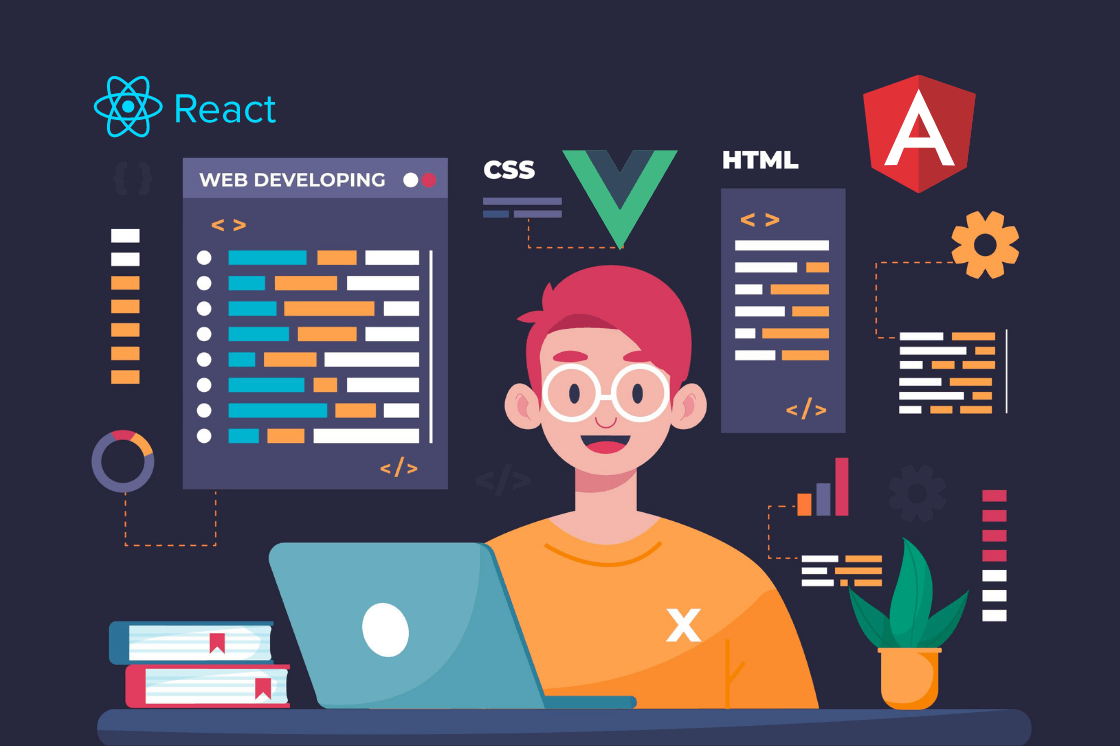Congrats, you’ve finally decided to create highly interactive, functional, and multifaceted web apps!
And if you’re running an online business or an eCommerce store, front-end frameworks are the tools you rely on the most.
What people see and experience must be seamless, no matter how complex the activities and operations are in the background.
Before heading ahead to the best frontend frameworks in 2021, let’s understand what it exactly means!
What is a Front-end Framework?
The front-end is the part of a website or application where users interact directly with it. Front-end frameworks are files and directories that include pre-written, standardized code. They serve as a foundation for creating dynamic apps that provide a great user experience.
You can use a front-end Framework to manage AJAX requests, associate data with Document object Model (DOM) elements, define a file structure, and style components on a website or application, among other things.
If you’re looking for the most efficient, popular, or promising frontend frameworks in 2021, this post has got you covered.
So, let’s discuss the most popular front-end frameworks to consider developing a web app without wasting time.
Best Frontend Framework 2021 To Consider
Here are the frontend frameworks that you must know about;
1. React.js
React is one of the most straightforward JavaScript UI frameworks to use, created and maintained by Facebook. It serves as the foundation for single-page and mobile apps. Since its inception in May 2013, the framework has been steadily gaining traction.
According to the study statistics, React is the most popular framework, with over 3 million users and a large developer ecosystem. Its rapid adoption and widespread appeal could be attributed to the Virtual Document Object Model (DOM) and 1-way data binding.
Furthermore, React.js dev tools is a Chrome DevTools extension for the open-source React JavaScript library that allows for investigating React component hierarchies.
Why Choose React.js?
- Backed by Facebook
- Constantly updated
- The Virtual Document Object Model (VDOM) enables document operations to be performed quickly.
- You can use it in conjunction with a variety of other JS libraries.
- Allows for the creation of components without the use of classes
- Migration between multiple versions is simple.
Let’s have a look at some of the most popular React applications:
- Airbnb
- UberEats
- Discord
- Myntra
2. Angular.js
This framework will require Node.js and will use either JavaScript or Typescript and some other existing technologies such as Angular CLI to make the generation of modules and code packages for the developer quick and straightforward. The close connection with Angular Material, a current design guideline that you’ve seen on countless websites, is what makes this framework so wonderful.
This is one of the best frontend frameworks in 2021 out there, with support from a huge corporation and a vast community.
Why Choose Angular?
- Architecture based on components
- Data binding in both directions
- Features like directives and dependency injection
- Applications that are highly tested, reusable, and manageable
- Increased server efficiency
- A strong community, excellent training materials, and so on.
Here are a few of the top web applications powered by Angular:
- The Guardian
- Upwork
- Netflix
- PayPal
- Lego
- Freelancer
3. Vue.js
Vue.js is a simple frontend framework that is widely used nowadays. It’s effective in resolving the issues that Angular developers face.
It is smaller and has two significant advantages: visual DOM and component-based. It’s also a two-way binding.
Vue.js is a versatile tool that may be used for a wide range of tasks. It can handle simple and complex tasks with ease, from online applications and mobile apps to progressive web applications.
Why Choose Vue.js?
- Small and quick
- Comprehensive documentation
- Easy to understand the syntax
- Suitable for newcomers
- Data binding in both directions
- Has a favorable impact on SEO
Here are a few well-known companies that use Vue js in their apps and websites.
- Reuters
- Alibaba
- 9gag
- Xiaomi
- Ride Receipts
4. jQuery
jQuery, which first appeared in 2006, is unquestionably one of the oldest yet most up-to-date frameworks available. The framework reduces the time and effort required to write JavaScript code. By altering CSS and the DOM, jQuery may improve the functionality and interaction of websites.
The framework is cross-browser compatible and works with nearly all web browsers, including Internet Explorer 6.0+, Firefox 2.0+, and Opera 9.0+. That’s not all, though. AJAX functionality is also supported by jQuery via numerous techniques.
It can also aid in the development of stable native mobile apps that provide an excellent user experience.
Why Choose jQuery?
- Beginner-friendly
- Enjoyable working with
- All major web browsers are supported.
- A wide range of plugins
- It has a solid and well-developed community.
- Provides a variety of DOM modification tools.
- SEO-optimized
A few of the top mobile sites developed with jQuery include:
- Dodge
- Disney World
- OpenTable
- SlideShare
- American Century
5. Ember.js
Ember.js is a popular front-end development framework comparable to Angular that enables two-way data binding. It’s designed to keep up with modern technology’s ever-increasing needs. Ember.js allows you to create complex mobile and web applications while relying on its efficient architecture to manage issues.
Ember.js’s learning curve has its few flaws but is one of the most difficult to learn. Because of its tight and conventional structure, the framework is one of the most difficult to learn. Furthermore, since it is new and under-explored, the development community is small. However, anyone can take advantage of this opportunity.
Why Choose Ember.js?
- Rendering on the server
- Documentation that is consistent
- Native debugging and testing tools
- Widget-based component approach
- Data binding in both directions
- A URL-centric strategy
- A well-organized Community
- TypeScript and JavaScript are supported.
Here are a few of the most popular Emberjs applications.
- Netflix
- Square
- Intercom
- Microsoft
- Apple
6. Backbone.js
Jeremy Ashkenas, the author of CoffeeScript, created it as a free, open-source JavaScript library in 2010. It’s free to use, thanks to the MIT software license. Backbone.JS has been utilized to develop 600,000 websites, according to 7% of front-end developers who have had a positive experience with it.
Backbone.js provides a robust API of enumerable functions for creating client-side web apps, declarative event handling for views, and a RESTful JSON interface to connect it all to your current API.
Why Choose Backbone.js?
- Extensible: more than 100 extensions are available.
- Fewer HTTP requests
- Beginner-friendly
- Small size: when minified and zipped, it’s about 7.6kb.
- In-depth tutorials that are well-organized
- Instead of putting data in the DOM, data is stored in models.
Here are some of the most popular applications using Backbone.js
- Uber
- Trello
- Tumbler
7. Semantic-UI
Despite being fresher than other frameworks, Semantic-UI has established itself as one of the most popular front-end frameworks in 2021. It is a great framework to work with because of its intuitive UI, broad capabilities, and usability.
The human-friendly approach to codes in Semantic-UI makes it self-explanatory – and hence simple to master. This makes it simple for newcomers to climb up swiftly and without difficulty. In addition, the framework supports smooth third-party integrations, making it more adaptable and user-friendly.
Why Choose Semantic-UI?
- Organic code that is self-explanatory
- User interface elements that are both rich and responsive
- Has React, Angular, Meteor, and Ember integrations
- A wide range of themes is accessible.
Several of the most popular mobile and web apps feature semantic UI, including:
- Snapchat
- Accenture
- Zomato
The Bottom Line
So, that’s a wrap to the best frontend frameworks in 2021!
Since there are many front-end frameworks to select from, you may be undecided about which one to choose. It is not simple to comprehend each, get practical experience, and then select amongst them.
Are you still confused, what to choose? If so, you’ve reached the correct destination! EitBiz is a leading tech-driven company with a skilled team of experienced software consultants who can assist you in defining your business goals and implementing the right frontend technologies for your circumstance. In addition, our talented front-end developers would also be happy to assist you in designing eye-catching applications that are relevant to your business.
To know more, simply visit https://www.eitbiz.com/ today!
Author
-

EitBiz is a fast-growing and dynamic software, mobile app and web design and development company, expanding to multiple countries.
View all posts






